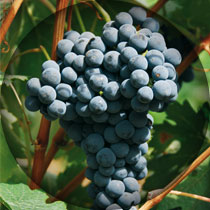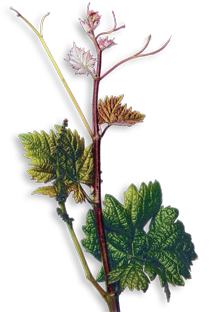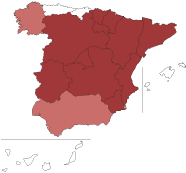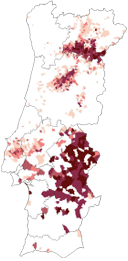Tempranillo (ES) / Aragonez (PT)
Variety: red | Category I | Portugal/Spain


General Information
Tempranillo


Aragonez


Origin: Spain, possibly Asturia; some even argue for France. What is certain is that the monks from Cluny distributed this variety along the Caminho de Santiago. Herrera (1513) mentions an Aragonez variety, whilst Valcárcel (1791) describes the Tempranillo in Rioja and Navarre. Clemente (1807) assumed Logroño to be the region of origin. In Portugal, it is not included in the descriptions of either Lacerda Lobo (1790), or Rebelo da Fonseca (1790), but Gyrão (1822) knew of the existence of this variety in the Douro. Vila Maior presumed the variety was imported from Spain to the Quinta da Romaneira, although it was not yet referred to as Tinta Roriz, as it is widely known in this area today.
Chief areas of distribution: Douro (4,000 ha), Spain (214,341 ha), France (2,500 ha), Argentina (12,000 ha), USA (250 ha), Australia (312 ha).
Official synonym(s) (national and OIV): Tinta Roriz (PT, ZA), Cencibel (ES).
Historic and regional synonyms: Tinta del País (ES), Tinto Fino (ES), Tinta de Toro (ES) Ull de Liebre (ES), Tinta Santiago (PT, Setúbal), Negretto (IT), Valdepeñas (US).
Homonym(s): Tinta Aragonesa (ES).
Area under cultivation: 23,500 ha (PT) and 214,341 ha (ES).
New plantings: Stable, at high level.
Trend: Downward.
Varietal variability: Medium.
Availability of propagating material: RNSV polyclonal material: Clones 106, 110, 111, 114, e117 JBP (Plansel); Clones 54 - 60 ENA. In Spain, there are very many clones in various regions, e.g. RJ-43 and RJ-51.
Molecular Profile (OIV)
Regional Classification
Morphology
Phenology
Vegetative Potential
Viticultural Parameters
Oenology
Variety Characteristics
| VVMD5 | VVMD7 | VVMD27 | VVS2 | ZAG62 | ZAG79 | ||||||
| Allele1 | Allele2 | Allele1 | Allele2 | Allele1 | Allele2 | Allele1 | Allele2 | Allele1 | Allele2 | Allele1 | Allele2 |
| 232 | 232 | 237 | 251 | 179 | 179 | 140 | 142 | 195 | 199 | 245 | 249 |
Young shoot (form of tip): Open with crimson red tip of medium intensity; medium to dense hairs.
Young leaf: Red stripes and green buds.
Young shoot: Yellow with bronze shading, ventral side medium density of hairs and erect hairs.
Inflorescence (sex of flower): Hermaphrodite.
Mature leaf: Large, pentagonal, five lobes, with upper lobe dominant, blade medium green, regular, rugose with light blistering. Very erect hairs of medium density on lower side of blade. Large convex teeth, overlapping U-shaped petiolar sinus, and overlapping U-shaped upper lateral sinuses.
Bunch: Medium size, cylindrical to conical, medium density, peduncle of medium length.
Berry: Round, medium size, blue-black, skin of medium thickness, flesh of medium firmness.
Woody shoot: Brown-yellowish.
Time of bud burst: Normal, 9 days after the'Castelão'.
Flowering: ormal, 6 days after the 'Castelão'.
Berry (colour change): Normal, 2 days before the 'Castelão'.
Berry (harvest ripe): Normal, at the same time as the 'Castelão'.
Vigour of shoot growth: Medium to high.
Pruning weight:: 2,000 – 3,000 kg/ha, depending on clone and soil conditions.
Shoot attitude (habit): Semi-erect and heliotropic.
Length of internodes: Long, regular.
Shoot length: Medium to long, poor lignification.
Tendency to form lateral shoots: Low. Form only if plant growth is very vigorous.
Rate of multiple bud bursts: Short, mostly herbaceous.
Bud fertility index: Medium. Index 1 = 1.17; 2 = 1.53; 3 = 1.54. flowers per shoot. Varies with rootstock: R99 = 1.75; 1103P = 1.36.
Yield: Index 338. High, but varies with soil. climate and clone: 8 - 18 t/ha (with clone P1103 = 8 t/ha, with clone R99 = 18 t/ha). (RNSV statistical value: 2,586 kg/vine (average of at least 40 clones in Reguengos over 6 years).
Yield consistency: High yields normally followed by lower yields.
Winkler Index: 1,490 - produces an 11 t/ha yield (Montemor).
Sensitivity to abiotic factors: Drought tolerant. Leaves become scorched and fall off in extreme heat, particularly with rootstock P1103.
Susceptibility to fungal diseases: Susceptible to Oidium, medium susceptibility to Peronospora, Excoriosis (Phomopsis viticola Sacc.) (Phomopsis), Esca, and Eutypia.
Systemic viral infection prior to selection: : 3% GLRaV-1, 18% GLRaV-3, 30% GVA, 5% RRV, < 50% RSP.
Susceptibility to Pests: Vine leafhopper.
Bunch size: Medium to large (200 – 500 g, depending on clone and climate).
Bunch density: Normally quite loose.
Berry size: Medium (1.2 – 1.8 g per berry), difficult to detach.
Berry skin: Medium to thick, resistant to heat.
Seeds per berry: On average, 1.6-2, depending on the clone and environment.
Vineyard conduction system: Any type. Shoots at risk of breaking if tied.
Soil requirement: If possible, deep soils with good drainage, and limited availability of water. Too much water leads to delays in ripening and reduced quality.
Climatic requirements: Climate needs to be dry and very hot to achieve quality.
Vine density: Depends on crop load.
Rootstock: hoice of rootstock affects bud fertility and, indirectly, alcohol content. Recommended: 1103 P and 196-17 both of which result in high yields; R99 and R110; Not recomended: Rupestris du Lot.
Incidence of coulure/millerandage: Flower susceptible if there is a sudden fall in temperature.
Spoilage of mature berries: Fairly minimal.
Risk of bird damage: Protection strongly recommended.
Machine harvest suitability: Harvests at high temperatures during August can only be done at night. With very high yields, berries split easily, which causes oxidation.
Wine type: Table wine, quality red wine, dessert wine.
Potential alcohol content: High, 13% - 14% vol. (RNSV statistical value: 13.28% vol.; average of at least 40 clones in Reguengos over 3 years).
Natural acidity of must: Medium to low (total acid content, 4 - 5 g/l; malic acid, 1.6 g/l; tartaric acid, 3.8 g/l). (RNSV statistical value: 2,86 g/l, average of at least 40 clones in Reguengos over 3 years).
Total anthocyanins: 669.8 mg/l. (RNSV statistical value: 669.26 mg/l; average of at least 40 clones in Reguengos over 3 years).
Total phenols index (at 280 nm) of must: 43.9. (RNSV statistical value: 43.95; average of at least 40 clones in Reguengos over 3 years).
Risk of oxidation of must: Low.
Colour intensity of wine: High for must (8-14, depending on the clone). Risk of loss of intensity during fermentation
Wine colour tonality: 0.6 – 0.8, depending on the clone.
Tannins: Monomeric 10 mg/l; Oligomeric 100 mg/l; Polymeric 570 mg/l. Oligomeric Prozyanidine: B1, 11 - 44,7 mg/l; B2, 7.7 – 21.0 mg/l; T2, 1 - 10 mg/l.
Total polyphenol index (at 280 nm): 19 - 75 (Total polyphenols: 1,712 – 2,729 mg/l).
Risk of oxidation of wine: Low, when alcohol content is high.
Aromatic profile: Total terpenoid compounds (Analysis, Alentejo in 1997 and 1998), 202 μg/l (1997), 199 μg/l (1998). Total benzenoids, 1,034 μg/l (1997), 588 μg/l (1998). Norisoprenoids, 821 μg/l (1997), 363 μg/l (1998).
Ageing Potential: High. Well suited to ageing in wooden barrels.
Blending recommendation: Tourigas, Tinta Barroca, Tinto Cão, Trincadeira, Alicante Bouchet.
Wine Descriptors: This variety's wines are distinguished by good, strong colour and an intense and complex aroma structure. At first, its gives aromas of plums and fruits of the forest, which develop into new complexes with ageing. Smooth in taste, the Aragonez wines possess a tartness, are well structured, tannin-rich and multi-layered. Any sampling will reveal the wine's high standard for which this variety earned its reputation. (Paulo Laureano)
Wine quality: This is a premium grapevine variety in both Spain and Portugual, but despite this, a controversial one because of its tendency to produce either too much, or not enough, wine. It is only with strict yield controls that it is possible to produce one of the best wines on the Iberian Peninsula. Its irregular yield pattern can occur within a single vineyard over successive years.
Variety Characteristics: unavailable

